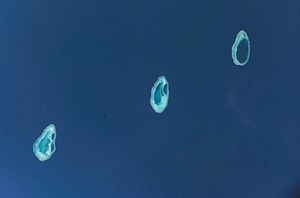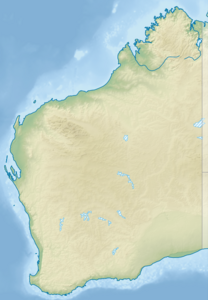Rowley Shoals
| Rowley Shoals | ||
|---|---|---|
|
Satellite image of the Rowley Shoals atolls (from right: Mermaid Reef , Clerke Reef and Imperieuse Reef ) |
||
| Waters | Indian Ocean | |
| Geographical location | 17 ° 20 ′ S , 119 ° 20 ′ E | |
|
|
||
| Number of islands | 3 atolls with 2 islands |
|
| Main island | Cunningham Islet (in Imperieuse Reef) |
|
| Residents | uninhabited | |
Rowley Shoals (= "shoals") is a group of three atoll-like coral reefs protruding from the water off the Australian northwest coast, about 260 kilometers west of Broome .
geography
The archipelago lies on the edge of one of the largest shelves in the world. Each of the atolls covers an area of about 80 to 90 km² (mostly lagoons and reef areas, as the land areas are very small). Politically, they belong to the Australian state of Western Australia . They all rise steeply from the surrounding ocean floor and lie on the same underwater platform as the Scott and Seringapatar reefs further northeast . The name of the group is derived from Captain Josias Rowley , who discovered the Imperieuse Reef in 1800.
It is believed that the atolls have been visited by fishermen from what is now Indonesia since at least the mid-18th century , who the Rowley Shoals probably knew as Pulau Pulo Dhaoh . Fishermen from the island of Roti, southwest of Timor , later named the islands Pulau Bawa Angin . The Mermaid Reef was known as Pulau Manjariti , Clerke Reef as Pulau Tengah and Imperieuse Reef as Pulau Matsohor . Sea cucumbers , turtles , trochus sea slugs and sharks were hunted here .
Mermaid Reef
Mermaid Reef, the northeasternmost of the three reefs (17 ° 06′S, 119 ° 37′E), is an atoll with a large lagoon enclosed by a coral ring. At the northeast end of the ring is a passage that is about 60 meters wide and leads into the lagoon. In front of Mermaid Reef, the seabed sinks rapidly by 440 meters. The atoll was named in 1818 by Captain Philip Parker King , who discovered the reef and named it after his ship.
Clerke Reef
Clerke Reef (also called Minstrel Shoal), is located at 17 ° 19′S, 119 ° 21′E and about 23 kilometers southwest of Mermaid Reef. The north-south length of the reef is about 15 kilometers with a width of 6 kilometers. At the northern end of the island is Bedwell Islet, a bare sand hill, 2 meters high. Here, too, a narrow passage leads into the lagoon, here too the seabed drops off immediately, here by 390 meters. Like Mermaid Reef, Clerke Reef was named by Captain Philip Parker King, namely after Captain Clerke, who had already reported on the reef between 1800 and 1809.
Imperieuse Reef
Imperieuse Reef, 17 ° 35′S, 118 ° 55′E, is a further 35 kilometers southwest of Clerke Reef, making it the most south-westerly point of the Rowley Shoals. It measures about 16 kilometers in the north-south extension with a width of 8 kilometers. On the southeastern edge of the reef there are numerous coral rocks that protrude up to 3 meters above the water level. Large parts of the reef area come out at low tide. Imperieuse Reef has two lagoons, each with lots of coral. Near the north shore is Cunningham Islet, a small, vegetation-free sand island that protrudes 3.7 meters above the water. The islet is also surrounded by a small lagoon (93 meters) and the location of a lighthouse , Imperieuse Reef Light. The seabed drops 230 meters off Imperieuse Reef. This reef was also named by Captain Philip Parker King, namely after the ship from which it was first sighted by Captain Rowley.
natural reserve
Clerke and Imperieuse Reef form Rowley Shoals Marine Park , which was established in 1990 and expanded in 2004. The park is managed by the Department of Conservation and Land Management (CALM) of Western Australia . The nearby Mermaid Reef Marine National Nature Reserve is maintained by the Australian Nature Conservation Agency (ANCA) with the assistance of CALM.
tourism
To 1977, began from Broome to do with charter boats expeditions to the reefs for the purpose of fishing and diving from. Since then, public interest in the area has grown steadily and the Rowley Shoals have earned a reputation for being one of Australia's top scuba diving sites. The reefs are some of the most remote and unspoiled in the world.
literature
- PF Berry: Faunal surveys of the Rowley Shoals, Scott Reef, and Seringapatam Reef, North-western Australia Perth , Western Australian Museum, ISBN 0-7309-0340-0
Web links
- Oceandots, with photos, English ( Memento from December 23, 2010 in the Internet Archive )
- Information about the national park, English

